Dry open window (DOW) apparatus
Fang A
U.S. patent number 10,378,787 [Application Number 15/933,938] was granted by the patent office on 2019-08-13 for dry open window (dow) apparatus. The grantee listed for this patent is Zhihua Fang. Invention is credited to Zhihua Fang.
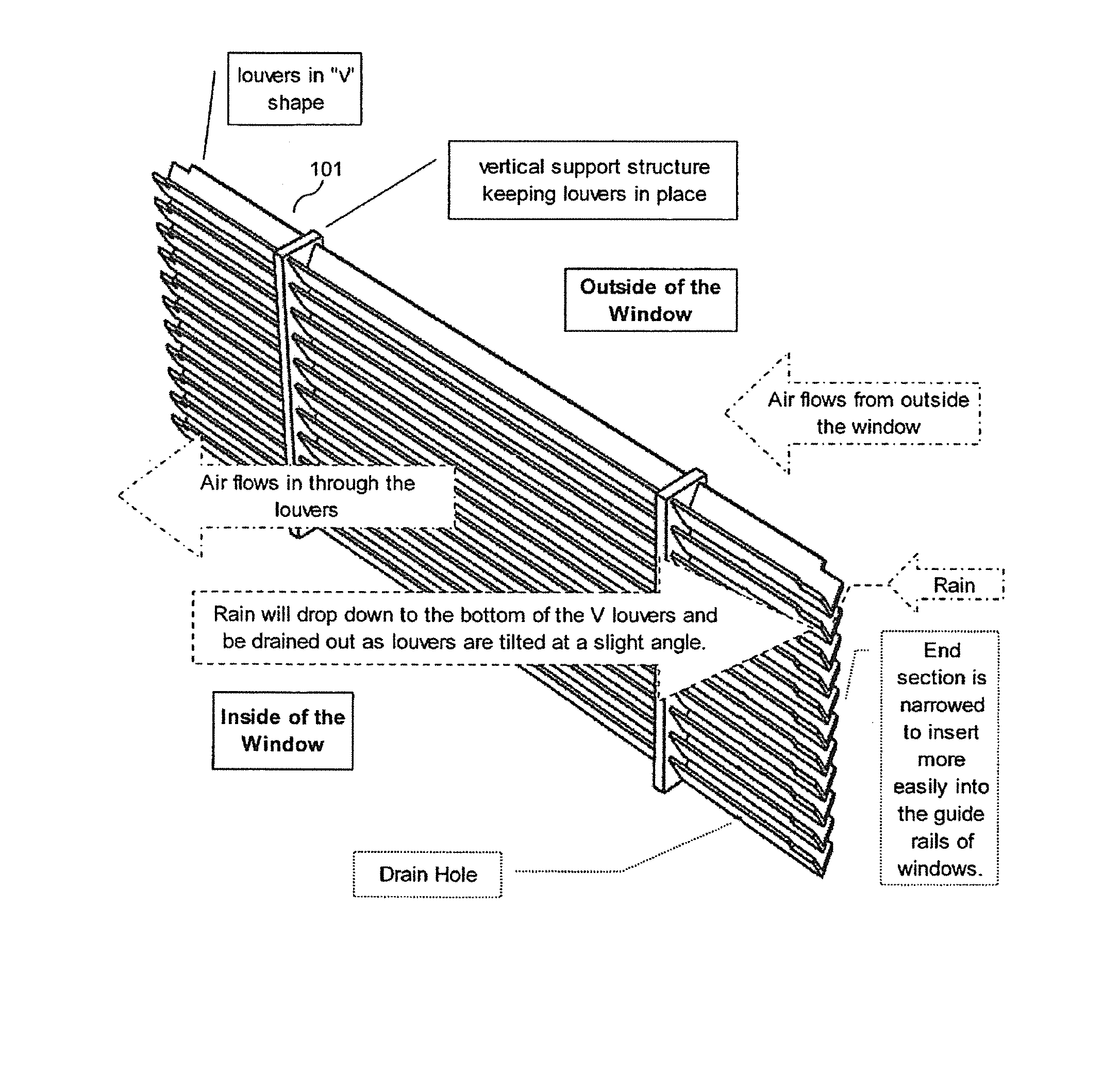

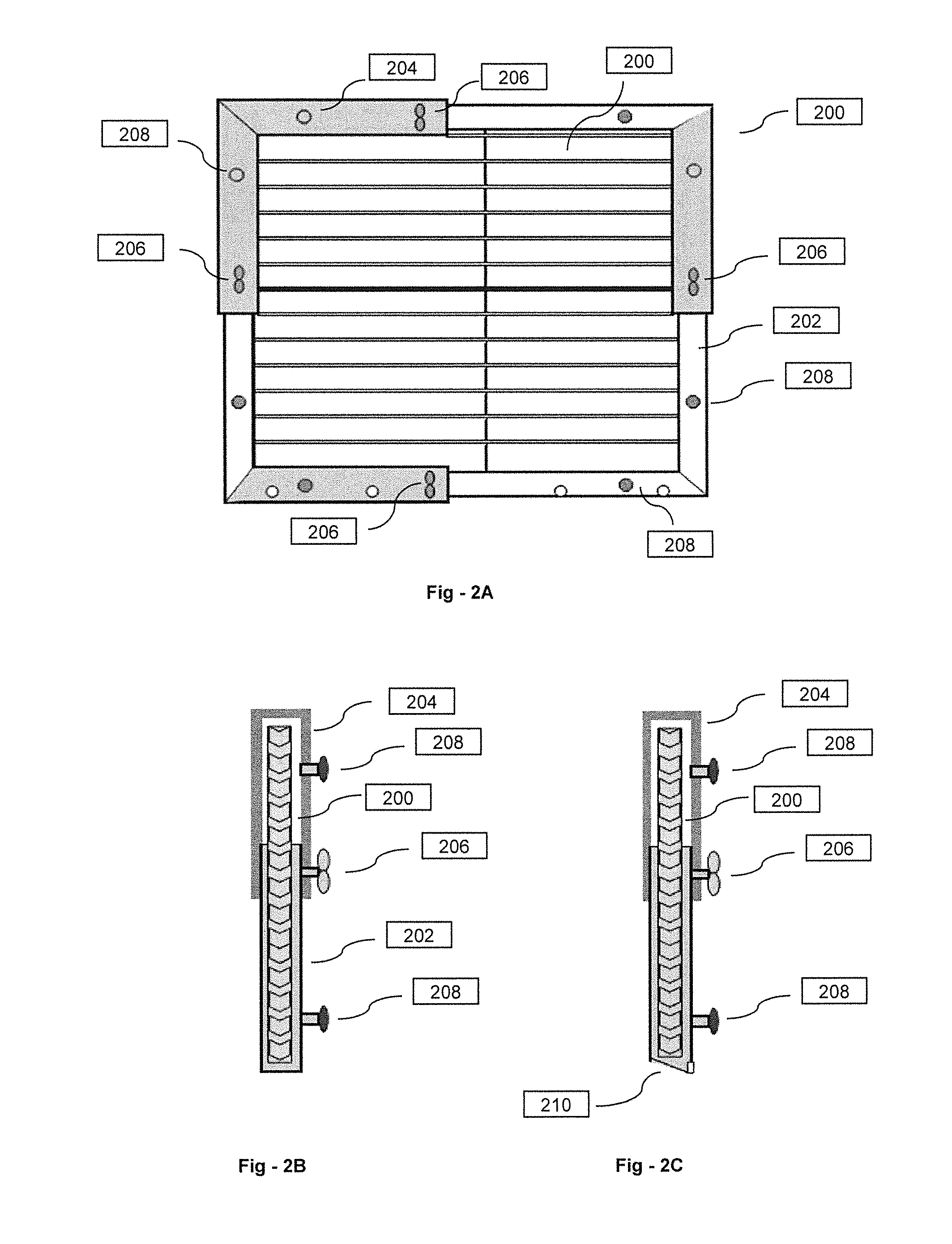

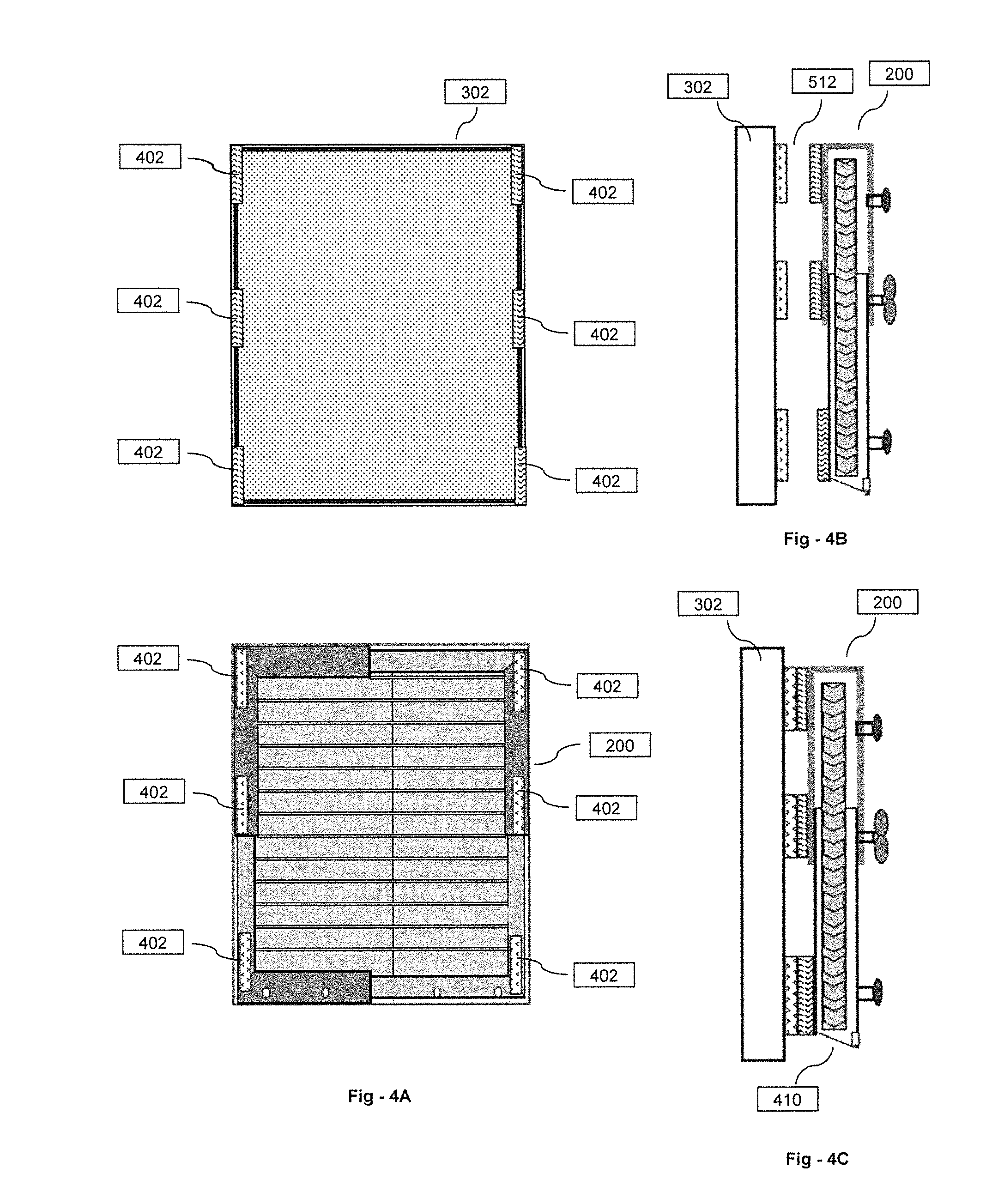

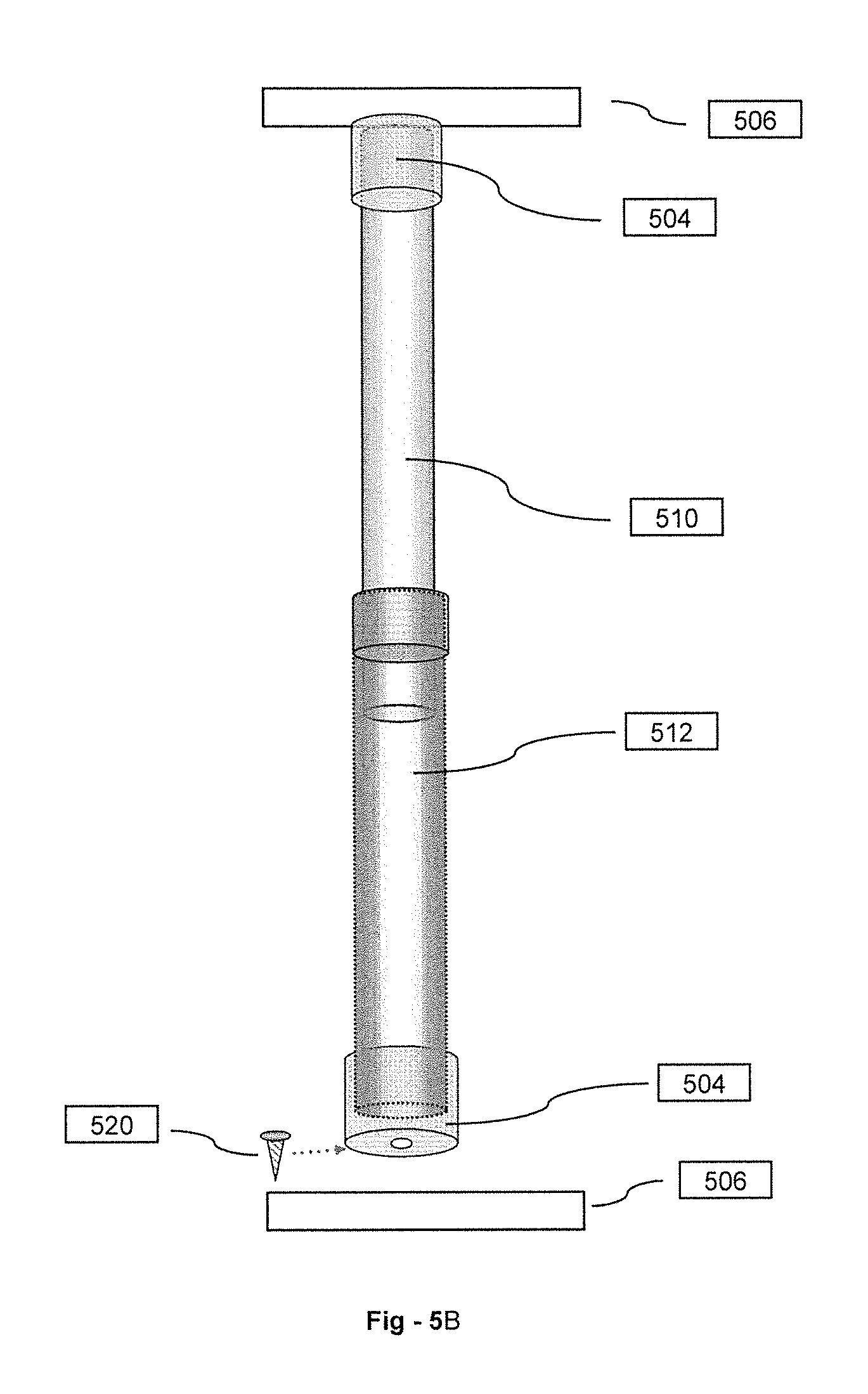


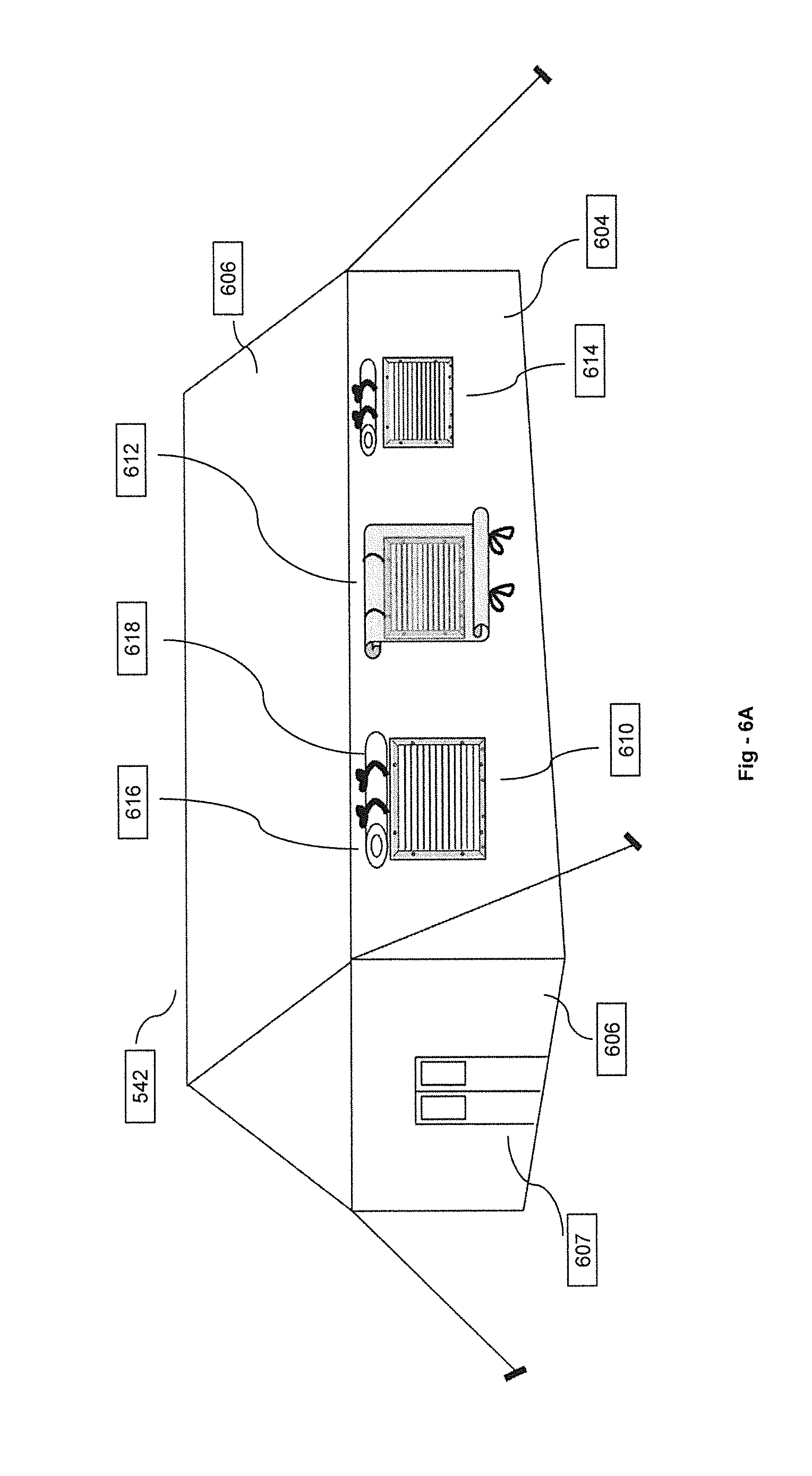
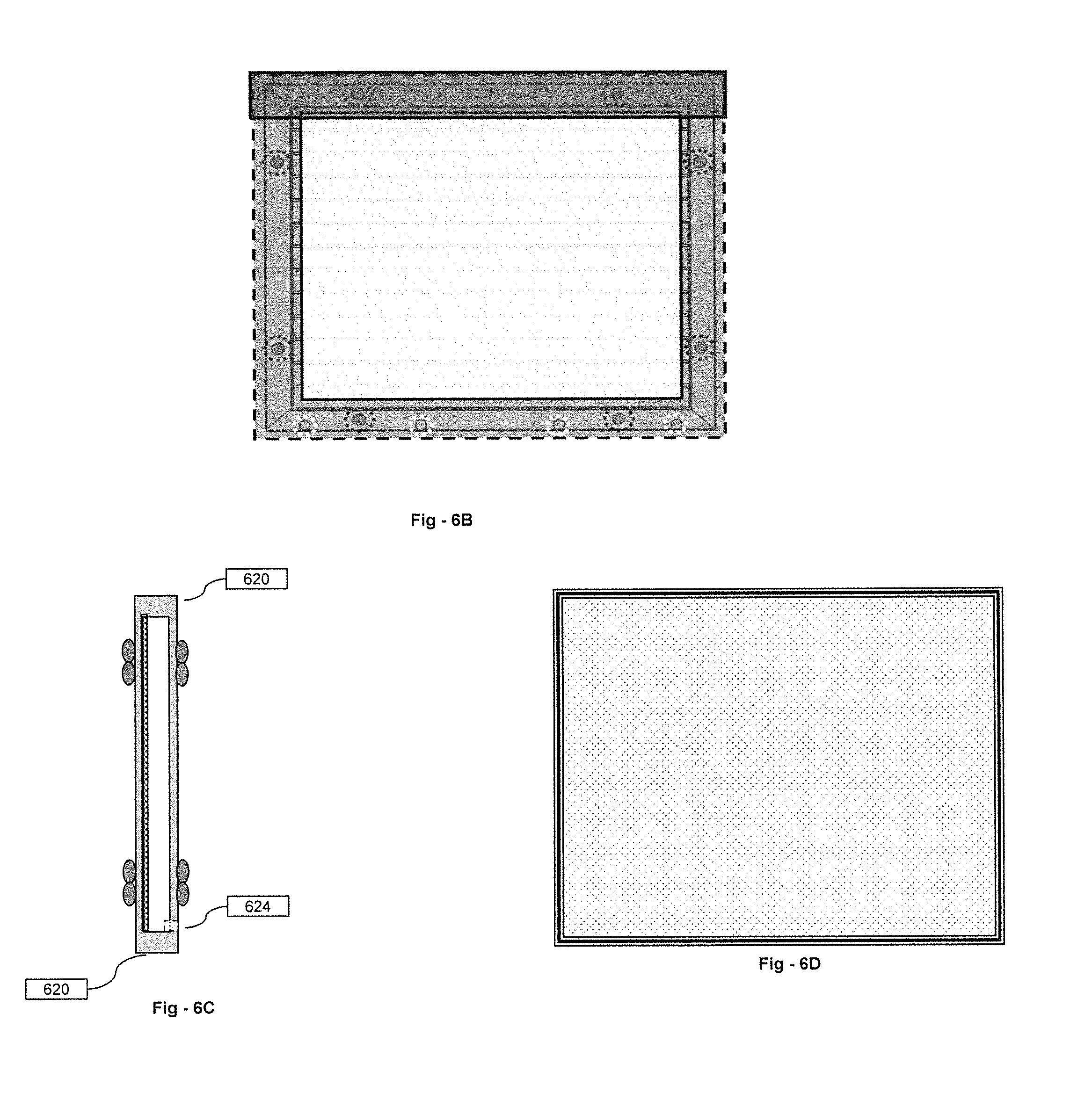
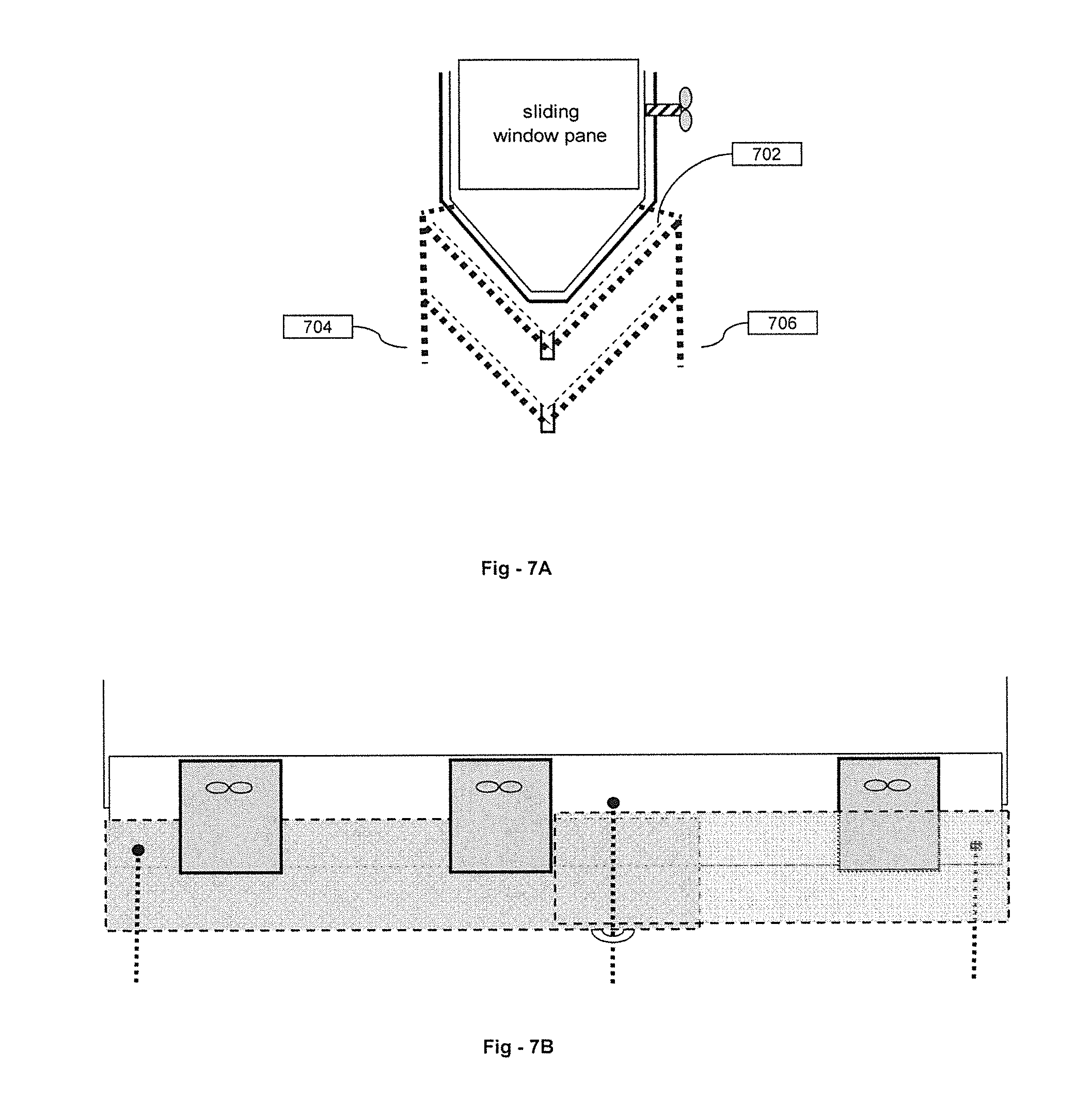
View All Diagrams
| United States Patent | 10,378,787 |
| Fang | August 13, 2019 |
Dry open window (DOW) apparatus
Abstract
Improvements in the manufacture, mounting and implementation of dry open window (DOW) structures. Such structures comprise a plurality of louvers which, when viewed in cross section, have "V" or "W" shapes that enable air to pass through a window opening while substantially preventing precipitation to pass, the precipitation instead being captured by the louvers for collection or drainage.
| Inventors: | Fang; Zhihua (Canton, MI) | ||||||||||
|---|---|---|---|---|---|---|---|---|---|---|---|
| Applicant: |
|
||||||||||
| Family ID: | 51259600 | ||||||||||
| Appl. No.: | 15/933,938 | ||||||||||
| Filed: | March 23, 2018 |
Prior Publication Data
| Document Identifier | Publication Date | |
|---|---|---|
| US 20180209686 A1 | Jul 26, 2018 | |
Related U.S. Patent Documents
| Application Number | Filing Date | Patent Number | Issue Date | ||
|---|---|---|---|---|---|
| 14251109 | Apr 11, 2014 | 9927141 | |||
| 12836574 | Jul 14, 2010 | ||||
| Current U.S. Class: | 1/1 |
| Current CPC Class: | E06B 7/082 (20130101); F24F 13/082 (20130101); F24F 2221/52 (20130101); F24F 2007/003 (20130101) |
| Current International Class: | E06B 7/02 (20060101); F24F 13/08 (20060101); E06B 7/082 (20060101); F24F 7/00 (20060101) |
| Field of Search: | ;454/196,212,224,905 |
References Cited [Referenced By]
U.S. Patent Documents
| 1118365 | November 1914 | Loehler |
| 1173548 | February 1916 | Beahan |
| 1307479 | June 1919 | Bolte |
| 1529711 | March 1925 | Parrot et al. |
| 1754559 | April 1930 | Johnson |
| 1798540 | March 1931 | Kelly |
| 2139781 | December 1938 | Trammell |
| 2155985 | April 1939 | Waterman |
| 2210516 | August 1940 | Wheeler |
| 2228224 | January 1941 | Benson |
| 2246413 | June 1941 | Jones |
| 2305445 | December 1942 | Poor |
| 2325003 | July 1943 | Backwith et al. |
| 2334454 | November 1943 | Taylor |
| 2341233 | February 1944 | Norton |
| 2469903 | May 1949 | Swanski |
| 2487108 | November 1949 | DeCarlo |
| 2527989 | October 1950 | Fuller |
| 2633191 | March 1953 | Curtis |
| 2741973 | April 1956 | Swor |
| 2779402 | January 1957 | Canning |
| 3008403 | November 1961 | Van DeVeire |
| 3086442 | April 1963 | Waldron |
| 3151714 | October 1964 | Kennedy |
| 3287870 | November 1966 | Johnson |
| 3358580 | December 1967 | Freese et al. |
| 3628442 | December 1971 | Nijhuis |
| 3771430 | November 1973 | Lane |
| 3782050 | January 1974 | Dowdell et al. |
| 3991533 | November 1976 | Nagase |
| 4064670 | December 1977 | Lichtenwald |
| 4103468 | August 1978 | Olsen |
| 4252076 | February 1981 | Williams |
| 4263842 | April 1981 | Moore |
| 4310993 | January 1982 | White |
| 4365930 | December 1982 | Ogura et al. |
| 4452024 | June 1984 | Sterriker et al. |
| 4858400 | August 1989 | Foyt |
| 4958555 | September 1990 | Lentz et al. |
| 5334091 | August 1994 | Shih-Chin |
| 5465776 | November 1995 | Mirza |
| 5542224 | August 1996 | Olsen |
| 5658130 | August 1997 | Goldstein et al. |
| 5782051 | July 1998 | LaVoie |
| 5979533 | November 1999 | Dupuie |
| 6196292 | March 2001 | Jackson |
| 6286579 | September 2001 | Gottschalk |
| 6378262 | April 2002 | Mercadante |
| 6658793 | December 2003 | Perron |
| 6745522 | June 2004 | Germain |
| 6923250 | August 2005 | Hegg et al. |
| 7165596 | January 2007 | Helton |
| 9927141 | March 2018 | Fang |
| 2005/0252086 | November 2005 | Yorgason |
| 2007/0144454 | June 2007 | Lee et al. |
| 2007/0187042 | August 2007 | Kallstrom |
| 2008/0207112 | August 2008 | Michieli |
| 2010/0099349 | April 2010 | Gohring et al. |
| 2010/0332034 | December 2010 | Bergeson et al. |
| 2011/0039490 | February 2011 | Wiese |
| 2011/0093122 | April 2011 | Koumoudis |
| 2011/0162808 | July 2011 | Castel |
| 2012/0015596 | January 2012 | Fang |
| 2012/0060802 | March 2012 | Livingston |
Attorney, Agent or Firm: Wathen; Douglas
Parent Case Text
REFERENCE TO RELATED APPLICATION
This application is a continuation application of U.S. patent application Ser. No. 14/251,109, filed Apr. 11, 2014, which is a continuation-in-part of U.S. patent application Ser. No. 12/836,574, filed Jul. 14, 2010, the entire content of which are incorporated herein by reference.
Claims
The invention claimed is:
1. An environmental window apparatus, comprising: a dry open window (DOW) structure having a plurality of louvers which, when viewed in cross section, are formed in the shape of a "V" or "W" that enable air to pass through a window opening while limiting passage of precipitation, the "V" shape disposed with a narrower end pointed downward and two portions sloping upwardly therefrom or the "W" shape disposed with two narrower ends of the shape pointed downward and two portions sloping upwardly from each of the narrower ends such that the precipitation instead is captured by the louvers for collection or drainage; and a plurality of rigid vertical members supporting the louvers in a spaced apart arrangement; wherein the rigid vertical members are adapted to be fixedly supported in a window opening such that the DOW structure is held in a fixed position in an overlying registration with the window opening.
2. The environmental window apparatus of claim 1, wherein the plurality of vertical members comprises at least three vertical members.
3. The environmental window apparatus of claim 1, further comprising a roll-up cover for covering the DOW structure.
4. The environmental window apparatus of claim 1, further comprising a window pane adapter configured to attach to a window pane, the adapter having a V-shape to engage an upper one of the plurality of louvers.
5. An environmental window apparatus comprising: a dry open window (DOW) structure having a plurality of louvers which, when viewed in cross section, are formed in the shape of a "V" or "W" that enable air to pass through a window opening while limiting passage of precipitation, the "V" shape disposed with a narrower end pointed downward and two portions sloping upwardly therefrom or the "W" shape disposed with two narrower ends of the shape pointed downward and two portions sloping upwardly from each of the narrower ends such that the precipitation instead is captured by the louvers for collection or drainage; a plurality of vertical members supporting the louvers in a spaced apart arrangement; and a plurality of spaced-apart, telescoping rods that span a width of an existing window opening; wherein at least some of the plurality of vertical members include a plurality of holes or hooks; the holes or hooks engage with the rods to maintain the DOW structure in an overlying registration with the window opening.
6. The environmental window apparatus of claim 1, wherein the plurality of vertical members are configured such that the louvers extend therethrough.
7. The environmental window apparatus of claim 1, wherein the louvers are opaque or transparent.
8. The environmental window apparatus of claim 1, wherein each of the louvers includes a drain hole.
9. The environmental window apparatus of claim 1, wherein each of the louvers has a surface that is uneven.
10. The environmental window apparatus of claim 1, wherein each of the louvers comprises a composite louver having a pair of overlapping upper and lower louver portions, the portions being slidable relative to each other so as to adjust an overall length of the composite louvers.
11. An environmental window apparatus, comprising: a dry open window (DOW) structure having a plurality of louvers which, when viewed in cross section, are formed in the shape of a "V" or "W" that enable air to pass through a window opening while limiting passage of precipitation, the "V" shape disposed with a narrower end pointed downward and two portions sloping upwardly therefrom or the "W" shape disposed with two narrower ends of the shape pointed downward and two portions sloping upwardly from each of the narrower ends such that the precipitation instead is captured by the louvers for collection or drainage; and a plurality of vertical members supporting the louvers in a spaced apart arrangement; wherein each of the louvers comprises a composite louver having a pair of overlapping upper and lower louver portions, the portions being slidable relative to each other so as to adjust an overall length of the composite louvers; wherein the plurality of vertical members includes at least a first side member, a second side member and a central member, the central member supporting the louver portions where they overlap.
12. The environmental window apparatus of claim 5, wherein the plurality of vertical members comprises at least three vertical members.
13. The environmental window apparatus of claim 5, further comprising a roll-up cover for covering the DOW structure.
14. The environmental window apparatus of claim 5, further comprising a window pane adapter configured to attach to a window pane, the adapter having a V-shape to engage an upper one of the plurality of louvers.
15. The environmental window apparatus of claim 5, wherein the plurality of vertical members are configured such that the louvers extend therethrough.
16. The environmental window apparatus of claim 5, wherein the louvers are opaque or transparent.
17. The environmental window apparatus of claim 5, wherein each of the louvers includes a drain hole.
18. The environmental window apparatus of claim 5, wherein each of the louvers has a surface that is uneven.
19. The environmental window apparatus of claim 5, wherein each of the louvers comprises a composite louver having a pair of overlapping upper and lower louver portions, the portions being slidable relative to each other so as to adjust an overall length of the composite louvers.
20. The environmental window apparatus of claim 11, wherein the plurality of vertical members comprises at least three vertical members.
21. The environmental window apparatus of claim 11, further comprising a roll-up cover for covering the DOW structure.
22. The environmental window apparatus of claim 11, further comprising a window pane adapter configured to attach to a window pane, the adapter having a V-shape to engage an upper one of the plurality of louvers.
23. The environmental window apparatus of claim 11, wherein the plurality of vertical members are configured such that the louvers extend therethrough.
24. The environmental window apparatus of claim 11, wherein the louvers are opaque or transparent.
25. The environmental window apparatus of claim 11, wherein each of the louvers includes a drain hole.
26. The environmental window apparatus of claim 11, wherein each of the louvers has a surface that is uneven.
Description
FIELD OF THE INVENTION
This invention relates generally to dry open window (DOW) structures that let fresh air in but keep precipitation out and, in particular, to improvements in the manufacture, mounting and implementation of such structures.
BACKGROUND OF THE INVENTION
When windows are left open for fresh and cool air, rain and other forms of precipitation may come inside, particularly if blown in by wind. An open window is an invitation for flooding on any rainy day, especially during a windy thunderstorm. Therefore one cannot leave an open window unattended during the day when it may rain. During the evening, if a window is open to let in fresh cool air, if it starts to rain one may have to suffer the inconvenience of waking up, going to the open window now soaked in rain, closing the window, drying up the wet spot on the floor, and then trying to go back to sleep. This interrupts a good night's sleep, not to mention damaging the property around or below the window.
Although louvered windows have existed for a long time and are used in some houses in certain regions far south where the weather is mild, they cannot keep rain out when there is a steady wind, thus making them prone to flooding.
The alternative to the open window is most likely a closed window, which in hot weather necessitates the operation of an air-conditioning system. Without air conditioning, one would have to suffer the heat and suffocation in a close-off building or space. As energy becomes more and more expensive, and the world becomes more environmentally conscious, more people would like to have an open window to let the air flow through their residences or businesses. Yet, inclement weather makes the open window a liability, an inconvenience, and sometimes impossibility.
To address these problems, my U.S. patent application Ser. No. 12/836,574 discloses various devices that perform the dual function of letting fresh air in or through a building or structure while keeping rain out in inclement weather. Such devices, which I call dry-open-window or "DOW" devices, allow fresh air into a building or structure while keeping the rain out at wind speeds up to a certain limit. My published application also discloses a device in which a fan will be added to the DOW device, to further enhance the flow of the air from outside but will keep the rain out at the same time at wind speeds up to a predetermined limit.
More particularly, the DOW device is disposed in an open window or any opening, and secured against the window frame or the frame of the opening, to let the air through the window or opening. At the same time, however, the DOW device keeps rain drops or any other precipitation from entering the window or opening even though the rain drops or precipitation may be forced towards the window or opening, as by a wind or any other air movement.
The DOW fan works in conjunction with the DOW, and has all the functions of DOW, but includes a mechanized fan, typically driven by electricity, to increase the air flow through the window or the opening in either direction, but to keep rain drops or any other precipitation from entering the window or opening.
SUMMARY OF THE INVENTION
This invention resides in environmental window apparatus with the goal being to extend and improve upon existing dry open window (DOW) structures. Such structures comprise a plurality of louvers which, when viewed in cross section, have "V" or "W" shapes that enable air to pass through a window opening while substantially preventing precipitation to pass, the precipitation instead being captured by the louvers for collection or drainage.
One aspect of the invention resides in apparatus for mounting the DOW structure in overlying registration around the periphery of an existing window opening having a height and a width. Such mounting apparatus may include four corner frame members around and containing the DOW structure, each frame member having a first arm greater than half the height of the window opening and a second arm greater than half the width of the window opening. The first arm of each frame member is slidingly engaged with the second arm of an adjacent frame member, with fasteners being provided to lock the frame members to one another when they form an assembled rectangle with dimensions corresponding to the periphery around the window opening. A plurality of components are then provided for mounting the frame members and DOW structure contained therein to the periphery of the window opening.
The components for mounting the frame members and DOW structure contained therein may, for instance, include a plurality of threaded fasteners that extend through portions of the assembled rectangle and around the periphery of the window opening. Alternatively, the components for mounting the frame members and DOW structure contained therein may include a plurality of hook-and-loop fasteners between the assembled rectangle and the periphery of the existing window opening.
A plurality of cables may be provided, each with one end mounted to different points around the periphery of the window opening, and wherein the cables then extend through portions of the frame assembly. In this embodiment, a mechanism for tightening the cables is provided such that the frame members and DOW structure are pulled against the existing window opening in overlying registration with the periphery thereof.
The existing window opening forms part of a collapsible tent structure made from tent materials. In this embodiment, the components for mounting the frame members and DOW structure contained therein may include a plurality of fasteners that extend through portions of the assembled rectangle, around the periphery of the window opening, and through the fabric of the tent materials. A roll-up cover may be provided over the mounted frame members and DOW structure. In this and all other embodiments, one or more weep holes may be provided along a bottom portion of the assembled frame to enable water to leak out.
The DOW structure may include a plurality of vertical members through which the louvers extend, each vertical member including a plurality of holes or hooks. In this case, the components for mounting the DOW structure includes a plurality of spaced-apart, telescoping rods that span the width of the existing window opening, and wherein the holes or hooks on the DOW structure engage with the rods to maintain the DOW structure in overlying registration with the window opening.
The DOW structure includes a plurality of vertical members through which the louvers extend, and each vertical member may feature an upper shape and a lower shape. In this embodiment the upper and lower shapes engage with one another, enabling a plurality of DOW structures to stack on top of one another to increase the height of the overall assembly.
The invention may further include a cable assembly enabling the angles of the louvers to be varied in accordance with weather conditions. The invention may additionally include a cable assembly enabling the spacing between the louvers to be varied in accordance with weather conditions or for shipment prior to assembly.
BRIEF DESCRIPTION OF THE DRAWINGS
FIG. 1 is drawing of a prior art dry-open-window (DOW) device with "V"-shaped louvers;
FIG. 2A is a drawing that shows an extendable frame embodiment of the invention;
FIG. 2B is a cross-sectional view of the embodiment of FIG. 2A seen from the top;
FIG. 2C is a cross-sectional view of the embodiment of FIG. 2A seen from the side;
FIG. 3A illustrates an extensible DOW device and optional overlying screen;
FIG. 3B shows the screen in overlying registration with the DOW device and one twist and tight fastener;
FIG. 3C is a top-down view showing the relationship between the component parts but without screen;
FIG. 3D is a detail drawing that shows how string may be anchored to a structure using a mounting plate;
FIG. 4A shows Velcro pads attached to both the window frame and the DOW device, at matching points, so that when they are pressed against each other, they form a bound between them;
FIG. 4B is a side view showing the relationship of the components prior to assembly;
FIG. 4C is a side view showing the relationship of the components following assembly, when the window frame and the DOW extendable frame are pressed together;
FIG. 5A is an oblique drawing that illustrates a rod-and-hook DOW mounting configuration;
FIG. 5B is a detail drawing of a rod;
FIGS. 5C and 5D are side views of DOW devices having hooks or other structures that engage with the rods;
FIG. 5E is an oblique drawing of a DOW device equipped with hooks of FIG. 5C;
FIG. 6A shows a DOW arrangement suitable to tent structures;
FIGS. 6B-6D illustrates different views of a DOW application for tent structures;
FIG. 7A is a side, cross-sectional view of a louver angle adjustment mechanism;
FIG. 7B is a front view of the louver angle adjustment mechanism;
FIG. 8A is a side, cross-sectional view of a DOW collapsing mechanism;
FIG. 8B is a front view of the DOW collapsing mechanism; and
FIGS. 9A-9C show how DOW devices may be equipped with the ability to be stacked on top of one another to maximize airflow while maintaining the same capability to keep the rain out.
DETAILED DESCRIPTION OF THE INVENTION
By way of review, FIG. 1 is an illustration of a DOW device, demonstrating how "V"-shaped louvers let air flow from outside a window through the device into a living space while keeping precipitation out. As disclosed in pending U.S. patent application Ser. No. 12/836,574, louvers with other cross sections, including "W" and "S" shapes may be used. The improvements disclosed herein are fully compatible with all of the embodiments described in my published '574 Application, including drainage structures and, indeed, the improvements are also compatible with my previously disclosed DOW fan concepts.
Certain of the improvements disclosed herein reside in attachment mechanisms enabling DOW structures to be custom mounted to randomly sized openings. The DOW devices are enabled with a series of attachment tools that will allow the device to be attached to any opening, window, door, or any other part of a structure, in all cases to let air in but keep the rain out.
Extendable Frame Embodiment
FIG. 2A is a drawing that shows an extendable frame embodiment of the invention depicted generally at 200. FIG. 2B is a cross-sectional view from the top, and FIG. 2C is a cross-sectional view from the side. The DOW device is shown at 201. The extendable feature is achieved by inserting a smaller tubular frame 202 into a larger tubular frame 204 whose hollow diameter is just big enough to allow the smaller tubular frame to glide into it.
The vertical sliding feature allows the extendable frame to accommodate various heights, and the horizontal sliding feature allows the extendable frame to accommodate various widths. Once the desired dimensions are achieved, screw-like bolts 206 can be tightened to disallow further movement of the frame. As shown at 210, a sloped bottom of the frame may be provided to allow water or rain to drain outside the window.
Attachment points 208 are nuts and bolts that will attach the extendable frame to the fixtures that will attach the whole device to the existing structure. Nuts of one kind or another are used for tightening; other attachment parts can be used alternatively for attachment, such as hooks, ropes, or Velcro, at the same or similar attachment points.
In summary, the frame features in this embodiment are extendable in height and width, and the attachments utilize devices such as screws, hooks, ropes, or other devices, that enable the device to be attached to the frame of the opening from the outside or inside. The extension feature is enabled by the use of interlocking channels, where one fits snugly into the hollow of another and is able to slide in and out.
The extension feature is provided on all four sides, and is attached to the DOW device with screws, nuts and bolts or other suitable fasteners. To attach the frame to an existing structure, the customer sizes the DOW device, attaches the DOW device to the frame provided at instructed points, and then holds the right-sized DOW device to the opening to gauge where the attachments points will be. The installer then can choose from a selection of attachment devices provided to attach the frame to the structure.
Screws are used as an option to attach the extendable frame (along with the DOW device) to an existing structure. A set of screws of adequate length are provided to go through predrilled holes in the extendable frame and into the existing structure. Preferably the screws are weather resistant; will have an adequate length to drill into wood, brick or concrete; and may be able self-tapping for use with aluminum or steel. As a further option, ropes may be provided enabling users to tie the extendable frame to an existing structure at various selected attachment points.
`Twist and Tight` Embodiment
The "twist and tight" mechanism illustrated in FIG. 3 is used to pull a cable tight so that the DOW device is pulled tight against an existing window frame 300. As shown in FIG. 3A, this embodiment may be used with an extensible DOW device and optional overlying screen 302. FIG. 3B shows the screen in overlying registration with the DOW device and one twist and tight fastener 310. FIG. 3C is a top-down view showing the relationship between the component parts but without screen 302. Once the cable 304 is pulled, the installer twists a wing nut 306 on tube 308 to tighten the string against a tube.
FIG. 3D is a detail drawing that shows how string 304 may be anchored to a structure using mounting plate 312. The base comprises a flat plate 312 with a small hook 314 attached to it. The steel cable is then looped through the hook and then fastened with a ring 316 that will crimped against the thin steel cable, as shown. Note that the positions of the base and the locking device can be switch from inside to outside.
The tightening device comprises a tube 308 whose inner diameter is slightly bigger than the steel cable 304 that runs through it. In FIG. 3B, the DOW device with the extendable frame is set against the window frame and against the screen. They are locked together with the locking mechanism demonstrated at the lower left-hand corner, with the understanding that more of the mechanisms may be used, in other corners, for example, as necessary. In the preferred implementation, there is a fastening mechanism for each corner of the window for secure attachment of the DOW device to the window.
A twisting mechanism may be provided that enables the steel cable to be pulled through with the tube with twist of a knob. The knob is attached to a rotating steel drum with teeth that pull the steel cable through as the knob is turned. The installer in this case is instructed to position a set of the twisters diagonally against the corner of the existing window frame. Four such twist and tight devices are provided, one for each corner of the DOW. As the thin flexible steel cord is pulled through, the distance is shortened between the DOW frame and the twister, which tightens the DOW frame against the existing window and the twister against inside window frame, thus tightening the device against the window.
Adhesive and Velcro Attachment Mechanisms
A suitable bonding agent may also be used as an option to attach the DOW device or the extendable frame to an existing window or the structure around an existing window. Adhesive materials with great adhesive power that holds up weights of 10 lb. or more will be used to attach the extendable frame to existing building structures to allow the DOW device to be installed to cover an opening.
In terms of installation, first the installer will attach the DOW device to the extendable frame. The installer then determines the attachment points for the extendable frame to be attached to the existing building structure so that the DOW device will cover the opening fully. With one person holding the frame (along with the DOW device attached), another person can extend or contract the extendable frame to figure out the best attachment points. Once positioned properly, the installer will be instructed to press the adhesive between the extendable frame and the surfaces of the existing structure. The adhesive will then firmly attach the extendable frame and the DOW device to the existing structure, and the DOW device will function properly at the opening to let air in and keep the rain out.
As an alternative to a permanent adhesive, hook-and-loop fasteners (Velcro) may also be used as a means to attach the DOW device or the extendable frame to an existing window or the structure around an existing window. Velcro is now available with great adhesive power that holds up weights of 10 lb. or more will be used to attach the extendable frame to existing building structures to allow the DOW device to be installed to cover an opening.
As shown in FIG. 4A, Velcro pads 402 are attached to both the window frame and the DOW device, at matching points, so that when they are pressed against each other, they form a bound between them. Note that the extendable frame need not have the attachment nuts and bolts and screws, etc. Note further that the Velcro strips can run the entire lengths and widths of the frame in order for a complete seal. FIG. 4B is a side view showing the relationship of the components prior to assembly, and FIG. 4C is a side view showing the relationship of the components following assembly, when the window frame and the DOW extendable frame are pressed together.
In terms of installation, first the installer will attach the DOW device to the extendable frame, then determine the position of the attachment points for the extendable frame to be attached to the existing building structure so that the DOW device will cover the opening fully. With one person holding the frame (along with the DOW device attached), another person can extend or contract the extendable frame to figure out the best attachment points. One side of the Velcro attachment system is then attached to the existing structure via attachment parts, such as with screws or glue. The other side of the Velcro attachment system is then attached to the extendable frame in the same locations. Once positioned properly, the installer will be instructed to position the extendable frame so the two sides of the Velcro systems will meet and hooked to each other. The Velcro system will then firmly attach the extendable frame and the DOW device to the existing structure; and the DOW device will function properly at the opening to let air in and keep the rain out.
Again as depicted at 410, the attachments have special drainage channels to guide the precipitation away from the inside of the house or building. That is, the louver will be positioned slightly lower at both ends than the middle, thus guiding the rain to flow to the ends, such that the water or rain will drain at the ends downward. Since the ends will be incased in a guide channel, the water or rain will flow downward without the possibility to flow inside the house. The bottom of the frame will have a higher height on the side toward the inside of the house and have a lower height toward the outside of the house, such that the bottom of the frame will form a slope toward the outside of the house. At the edge of the outside slope, there will be weep holes at certain intervals level with the lowest point of the bottom of the frame. When the water or rain reaches the bottom of the frame of the DOW device, it will follow the slope and drain outside the frame through the weep holes.
The various attachments may include airtight padding materials attached to the attachment frames or other devices, thus enabling the device and the attachments to contact building structures without any damage. All embodiments may have a removable screen that protects the occupants from mosquitoes, insects, and other small creatures that may invade the space protected by the DOW. The screen may be attached permanently or temporarily to the DOW device, while still allowing air to move through the DOW freely.
The screen may be attached to the extendable frame, which houses the DOW device. Strips of Velcro may be used for temporary attachment whereas screws may be used for more permanent attachment. Ropes, single-/double-sided tapes, or nuts and bolts may be used for temporary or permanent attachment.
Rod-and-Hook Mounting Configurations
FIG. 5A is an oblique drawing that illustrates a rod-and-hook DOW mounting configuration. In this embodiment, one or more rods 502 with end caps 504 are supported across a window or other opening 506. FIG. 5B is a detail drawing of a rod, and FIGS. 5C and 5D are side views of DOW devices having hooks or other structures that engage with the rods.
The thicker of the two tubes in the extension pole, its inter diameter is slightly bigger than the outer diameter of the slenderer tube, to allow the slenderer tube to slide back and forth, thus enabling the extension of the rod to varying lengths. The slenderer of the two tubes 510 in the extension pole will be able to slide in and out of the thicker tube 512 to achieve extension to varying lengths, to fit into windows of varying widths.
A twist lock mechanism 514, when twisted loose, allows the slenderer tube to pass through back and forth and then lock it up when twisted tight. There are commercially available twist lock products in the market that will tighten or loosen when the ring is turned one way or the other.
There is an end cap 504 at both ends. The cap has a hole to allow a screw 520 to pass through and attach the end cap to the window frame. When fixed to the window frame, it will receive the rod and hold the rod in place. In terms of dimensions, the length of each tube may be on the order of 25 inches; the diameter of the tubes are 1/2 inch for the slenderer tube; make the walls of the tubes and end caps about 50/1000 inch; therefore, render the diameters of the end caps and the thicker tube accordingly.
FIG. 5C is a side-view drawing of a DOW device 530 having hooks 532 that are spaced-apart to engage with rods supported within a window frame or other opening. FIG. 5D is a side-view drawing of an alternative DOW device 540 having through-holes 542 that are spaced-apart to receive rods supported within a window frame or other opening. The embodiment of FIG. 5D is similar to that of FIG. 5C except that it is more secure in the sense that the rods must be removed to move or remove the DOW device. FIG. 5E is an oblique drawing of a DOW device equipped with hooks of FIG. 5C.
The hooks or loops enable the extendable rod to go through them to the opposing walls. A socket with a diameter slightly larger than that of the extendable rod is attached to the opposing walls of the opening via a screw or other similar device. The extendable rod extends into the sockets and can be twisted tight to fix it in place. This ensures the louvers and the DOW device will stay in place despite moderate force exerted against it by either pushing or pulling the device.
Dow Tent Structures
FIG. 6A shows a DOW tent structure 606 with windows 614 that have DOW devices 610 inserted in them. As shown in FIG. 6B, the window frames 620 have a bottom sill 622 built in such a way that the bottom slopes downward towards the outside of the tent, with weep holes 624 at the very bottom of the sill at both ends and in the middle, to allow precipitation to drain outside the window and the tent.
Some tents can be made with DOW devices imbedded in them permanently, while allowing flaps 618 to cover up the window in extremely inclement weather. Some tents can be made with the DOW devices that can be removed for ease of folding and also for easy replacements. To enable the removal and reinstallation of the DOW, the tent can have the frame built into the tent, so the frame it a permanent fixture.
Alternatively, if the frame is not permanently attached to the tent, it may be attached to the tent via a series of hooks, screws, holes, and other means of attachment. The tent window is then purposefully designed and manufactured to accept the DOW with a frame. As a further alternative, the tent may include a canvas frame with a flap at the top or any side, which, when opened, can allow the DOW device to be insert into the canvas frame. The DOW device may also have attachments enabling it to be attached to existing tents. In any case, the DOW devices will have dimensions that will cover the vast majority of tent windows.
The DOW device may have a series of attachments in the form of screws, hooks, ropes, snaps, and other such fasteners to allow it to be attached to a tent window with little modification and overall ease. The DOW device may also have a locking mechanism to secure the louvers in place. The various supports may have hooks or loops that extend inside the space that the DOW protects.
Louver Angle Adjustment
In yet a further alternative embodiment, the DOW devices may be equipped with the ability to adjust the angles of the louvers to control the air flow or to shut down the air flow altogether. In this case, as shown in FIG. 7A, louvers 702 are connected with rope ladder 704, 706. As the rope ladder is pulled up or down at one side, the louvers will move accordingly. The rope ladder is connected to each louver through a hole in the louvers at defined intervals, especially at the ends, with a stopper at the underside of each louver, to enable the rope ladder to lift or lower the side of the louver the rope is on as the rope of the side is lifted or lowered.
FIG. 7B is a front view of this embodiment. The middle sections of the louvers are only saddled (without holes running through the louvers) by the rope ladder, which enables the upper sliding louvers to extend or contract to fit in windows of all sizes. The rope ladder for the middle sections may or may not be fixed to the underside of the lower louvers for rigidity or ease of assembly and operation.
The rope ladder is connected to a bar at the top that can extend, along with the sliding louvers, from a certain length to a greater length, to allow the DOW to fit in a wide variety of window openings. The mechanism to lift or lower one side of the louvers is achieved in a gear (not shown) in the bar at the top. The ropes run through a teethed rod that will rotate will the gears of a turning rod, which is controlled by the customer, like that of Venetian blinds. The louvers can also be connected to a rotary lever system to control the amount air flow through the opening by using various mechanisms. In one example, the user turns a long thin rod, the other end of the rod rotates as well. The other end of the rod is connected, through a lose connector that allows the thin rod to be detached, to a rotary mechanism.
The rotary mechanism may be toothed with rod running through it. As the rotary mechanism is turned by the thin rod, it rotates the rod. The rod is firmly attached to a piece of rigid material that runs the length of the DOW. The two long sides of the level piece are loosely attached at intervals with looped hooks to rigid vertical pieces, so that when the level piece pivots up or down, the rigid vertical pieces will move up and down in accordance. The rigid vertical pieces are connected loosely by a connector, such as a closed hook, to the horizontal louvers, such that the horizontal louvers move up and down with the rigid vertical pieces as they are moved up and down by the rotary mechanism. Using this arrangement, with a twist of the think rod, the louvers can be closed or be opened to the desired open setting, allowing the customer the desired amount air flow or no passage at all.
Collapsible Configurations
In the embodiment of FIGS. 8A, 8B, the DOW device has the capability to be collapsed into a small space for easy storage or extended to fill the opening. FIG. 8A is a partial cross section; FIG. 8B is a frontal view. The louvers 802 can be attached by strings 804, 806 that allow the user to fully or partially expand the device upward by pulling the top of the device. The DOW louvers are attached to the top of the device and strung together via a series of rope ladders. The rope ladders are attached to the louvers through holes in the louvers.
The rope ladders have fixed intervals that lift and separate the louvers at regular intervals when the rope ladders are lifted. The rope ladders also allow the louvers to collapse and be folded into a small pile. The rope ladders are attached to the V Top device. The V Top will be attached to the bottom of the window in various ways. It may also be attached to the bottom of the moveable window pane via the device of a clamped U shape that fits onto the bottom of the moveable window. Alternatively, it may be attached to the supporting rods at either end.
Stacking Capabilities
As shown in FIGS. 9A-C, the DOW devices may be equipped with the ability to be stacked on top of one another to maximize airflow while maintaining the same capability to keep the rain out. The top and the bottom of each DOW device are stacked on top of each other in cooperating alignment. The key feature that enables stacking is the shape of the top and bottom of the vertical support pieces 902. The tops of the support pieces, FIG. 9C are shaped with a concave profile 910. The bottoms of the support pieces, FIG. 9B, are shaped with a converse profile 912. The concave and converse shapes of the tops and the bottoms enable a perfect mate of the two pieces, enabling them to fit each other perfectly. The stacking is designed in such a way that there is no gap between the two devices stacked on top of each other, thus maintaining the devices' capability to keep the rain out while letting air flow through.
* * * * *
D00000

D00001

D00002

D00003

D00004

D00005

D00006

D00007

D00008

D00009

D00010

D00011

D00012

D00013
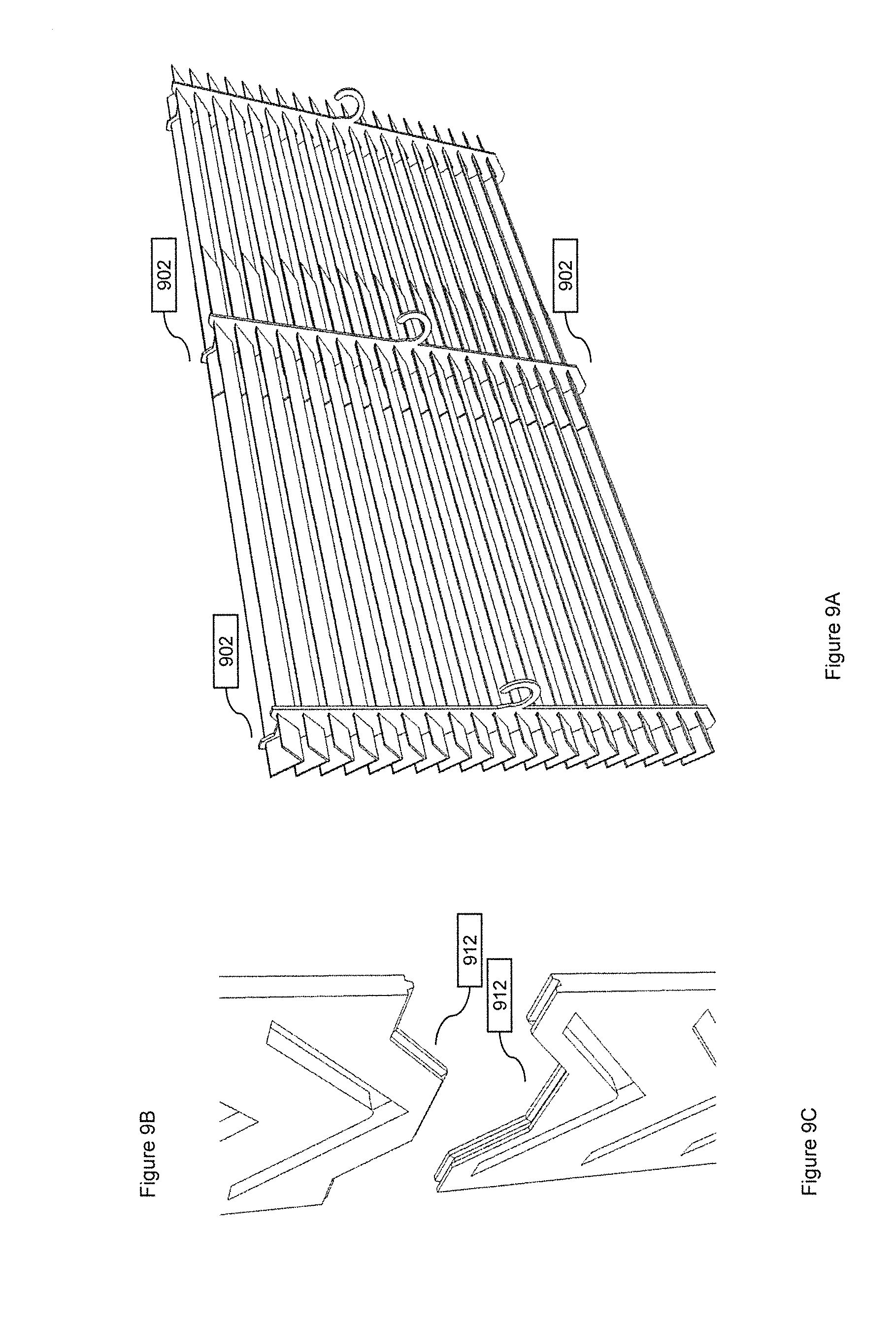
XML
uspto.report is an independent third-party trademark research tool that is not affiliated, endorsed, or sponsored by the United States Patent and Trademark Office (USPTO) or any other governmental organization. The information provided by uspto.report is based on publicly available data at the time of writing and is intended for informational purposes only.
While we strive to provide accurate and up-to-date information, we do not guarantee the accuracy, completeness, reliability, or suitability of the information displayed on this site. The use of this site is at your own risk. Any reliance you place on such information is therefore strictly at your own risk.
All official trademark data, including owner information, should be verified by visiting the official USPTO website at www.uspto.gov. This site is not intended to replace professional legal advice and should not be used as a substitute for consulting with a legal professional who is knowledgeable about trademark law.